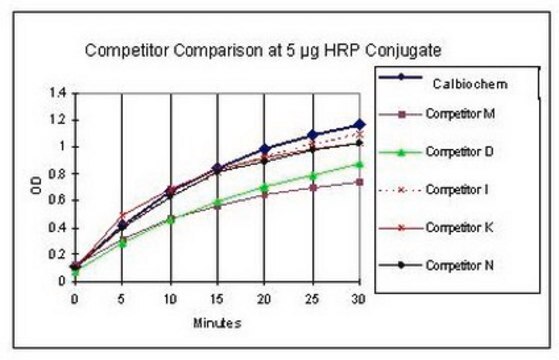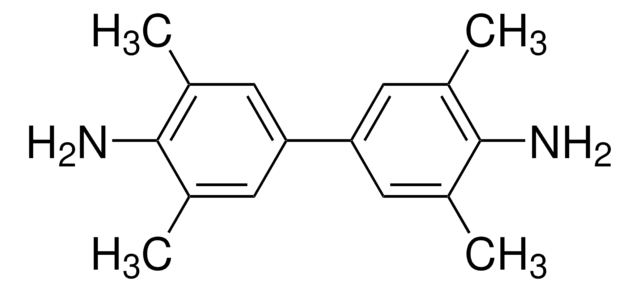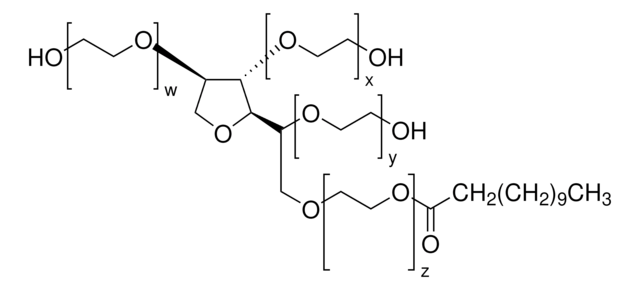ES001
TMB/E Single Reagent, Blue color, Horseradish Peroxidase Substrate (soluble)
500 ml TMB/E Single Reagent, Blue color, Horseradish Peroxidase Substrate (soluble) for ELISA.
Synonym(s):
HRP substrate, TMB
Sign Into View Organizational & Contract Pricing
All Photos(1)
About This Item
UNSPSC Code:
41116010
eCl@ss:
42029053
NACRES:
NB.22
Recommended Products
form
liquid
manufacturer/tradename
Chemicon®
technique(s)
ELISA: suitable
λmax
450 nm
shipped in
wet ice
General description
TMB, (3,3′,5,5′-tetramethybenzidine) has been shown to be a safe-sensitive substrate for the assay of HRP. Initially, in the presence of HRP and hydrogen peroxide, a one-electron oxidation product is formed. This compound, a cation free radical, is blue in color with an adsorption maximum of 653 nm. Further reaction with HRP/H2O2 or acidification of the radical with acid yields the diimine terminal oxidation product adsorbing light at 450 nm. The extinction coefficient of the radical (E653nm=3.9 x 104 mol-1 cm-1) and diimine (E450nm=5.9 x 104 mol-1 cm-1) provide a remarkably sensitive system for the assay of HRP and HRP labeled probes. ES001 is a single component reagent stable at room temperature and not sensitive to normal laboratory light. It is optimized with respect to TMB and hydrogen peroxide concentrations and yields a linear response with the concentrations of HRP usually employed in immunological assays.
Application
METHOD SYNOPSIS:
After completion of analyte binding to a solid phase and reaction with a HRP labeled probe, ES001 is added. Oxidation of TMB produces a blue reaction product that is measured at 650 nm. The color formation as a function of time can be recorded or the reaction stopped with sodium fluoride after a fixed interval. Increased sensitivity can be achieved by converting the blue radical to the diimine by addition of acid. The resulting yellow color is measured immediately at 450 nm.
SAMPLE PROCEDURE
1. Complete all required incubations with antibodies, probes, HRP labeled reagents.
2. Wash plate at least 4 times with PBS or Tris buffered saline containing 0.1% Tween-20.
3. After the final wash, shake and blot all residual buffer from plate wells.
4. Add 0.1 mL of ES001 (TMBE Solution) to appropriate wells and incubate 5-30 minutes.
Note: The reaction time will depend upon the activity of the HRP probe. If color develops too briskly, zero order kinetics will not prevail. Dilution of the probe, antibody or HRP labeled reagent may be required.
5. The reaction can be monitored as a function of time for kinetic assays or stopped with 0.1 mL of 0.1% sodium fluoride and read at 650 nm.
6. If the procedure demands conversion to the yellow diimine, add 0.1 mL of either acid described in the reagent section above and record the absorbance within 5 minutes.
Variations of time, reagent volume and temperature require standardization by the user.
After completion of analyte binding to a solid phase and reaction with a HRP labeled probe, ES001 is added. Oxidation of TMB produces a blue reaction product that is measured at 650 nm. The color formation as a function of time can be recorded or the reaction stopped with sodium fluoride after a fixed interval. Increased sensitivity can be achieved by converting the blue radical to the diimine by addition of acid. The resulting yellow color is measured immediately at 450 nm.
SAMPLE PROCEDURE
1. Complete all required incubations with antibodies, probes, HRP labeled reagents.
2. Wash plate at least 4 times with PBS or Tris buffered saline containing 0.1% Tween-20.
3. After the final wash, shake and blot all residual buffer from plate wells.
4. Add 0.1 mL of ES001 (TMBE Solution) to appropriate wells and incubate 5-30 minutes.
Note: The reaction time will depend upon the activity of the HRP probe. If color develops too briskly, zero order kinetics will not prevail. Dilution of the probe, antibody or HRP labeled reagent may be required.
5. The reaction can be monitored as a function of time for kinetic assays or stopped with 0.1 mL of 0.1% sodium fluoride and read at 650 nm.
6. If the procedure demands conversion to the yellow diimine, add 0.1 mL of either acid described in the reagent section above and record the absorbance within 5 minutes.
Variations of time, reagent volume and temperature require standardization by the user.
Physical form
Color Code: Yellow
REAGENT PROVIDED:
Liquid solution containing TMB, 1.25 mMol/L and Hydrogen Peroxide, 2.21 mMol/L and less than 1% dimethyl sulfoxide in a 0.08 Mol/L) acetate buffer at pH 4.9. Also contains non-toxic proprietary stabilizers.
Materials Required:
Reagents Required for Stopping the Reaction, But Not Provided
A. Sodium fluoride, 0.1% for stopping the reaction and preserving blue chromogen. Prepare by dissolving 1 g of sodium fluoride in 1 liter of reagent grade water. Observe all precautions on label for use of sodium fluoride.
B. Acid for stopping the reaction and converting the blue radical to the yellow diimine. Either 0.5 Mol/L sulfuric acid or 0.25 Mol/L hydrochloric acid may be used. THE ABSORBANCE MUST BE OBTAINED WITHIN 5 MINUTES AFTER ADDING THE ACID.
Note: Reagent grade water must contain less than 10-7 Mol/L of iron or copper salts otherwise unreacted TMB will be converted non-enzymatically to the diimine.
Liquid solution containing TMB, 1.25 mMol/L and Hydrogen Peroxide, 2.21 mMol/L and less than 1% dimethyl sulfoxide in a 0.08 Mol/L) acetate buffer at pH 4.9. Also contains non-toxic proprietary stabilizers.
Materials Required:
Reagents Required for Stopping the Reaction, But Not Provided
A. Sodium fluoride, 0.1% for stopping the reaction and preserving blue chromogen. Prepare by dissolving 1 g of sodium fluoride in 1 liter of reagent grade water. Observe all precautions on label for use of sodium fluoride.
B. Acid for stopping the reaction and converting the blue radical to the yellow diimine. Either 0.5 Mol/L sulfuric acid or 0.25 Mol/L hydrochloric acid may be used. THE ABSORBANCE MUST BE OBTAINED WITHIN 5 MINUTES AFTER ADDING THE ACID.
Note: Reagent grade water must contain less than 10-7 Mol/L of iron or copper salts otherwise unreacted TMB will be converted non-enzymatically to the diimine.
Storage and Stability
Maintain at room temperature for up to six months. For long term storage, up to twelve months, maintain at 2-8°C. Protect from exposure to direct sunlight. Discard if solution is blue or turbid.
Legal Information
CHEMICON is a registered trademark of Merck KGaA, Darmstadt, Germany
Disclaimer
Unless otherwise stated in our catalog or other company documentation accompanying the product(s), our products are intended for research use only and are not to be used for any other purpose, which includes but is not limited to, unauthorized commercial uses, in vitro diagnostic uses, ex vivo or in vivo therapeutic uses or any type of consumption or application to humans or animals.
Storage Class
12 - Non Combustible Liquids
wgk_germany
WGK 1
flash_point_f
Not applicable
flash_point_c
Not applicable
Certificates of Analysis (COA)
Search for Certificates of Analysis (COA) by entering the products Lot/Batch Number. Lot and Batch Numbers can be found on a product’s label following the words ‘Lot’ or ‘Batch’.
Already Own This Product?
Find documentation for the products that you have recently purchased in the Document Library.
Customers Also Viewed
Our team of scientists has experience in all areas of research including Life Science, Material Science, Chemical Synthesis, Chromatography, Analytical and many others.
Contact Technical Service






